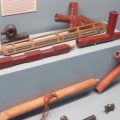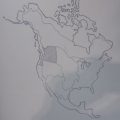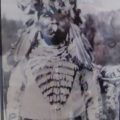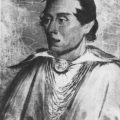
The Northeastern Atlantic Coast of the U.S. was dominated by Algonquian-speaking nations who practiced agriculture supplemented by hunting, fishing, and gathering. In general, tribes tended to be localized along major river drainages with a tendency for the people along each drainage to divide themselves into upstream and downstream groups.
Since much of the Native culture of this area had disappeared or gone underground due to the impact of the European settlers and their refusal to view Native American spirituality as a legitimate religion, relatively little is known about the traditional spiritual practices. Micmac poet Rita Joe, in her book Song of Rita Joe: Autobiography of a Mi’kmaq Poet, writes:
“More than anything else, I have been afraid to write about the spiritual part of things; Native spirituality is not easily understood.”
Anthropologist Ives Goddard, in his entry on the Delaware in the Handbook of North American Indians, writes:
“Delaware religion in the earliest period is poorly known because the Europeans who described it knew little about the system of beliefs as a whole and often misunderstood the significance of the rituals they witnessed.”
Generally, Native American spirituality in this area is considered to be animistic: that is, the people saw themselves as a part of nature. All things were alive—that is, they had souls. These living entities included the animals, the plants, the rocks, the mountains, the rivers, the thunder, and so on. Humans did not have dominion over these people.
Both animate and inanimate objects were treated as equals, not only to each other, but to humans as well. Anthropologist Kathleen Bragdon, in her book Native People of Southern New England, 1500-1650, reports:
“As the universe was socially constituted, relations with the other-than-human were conducted along the same lines as were those with human beings.”
Life and death were seen as a part of a continuum, and some ceremonies involved ritual rebirth.
The cosmology of the tribes of the Atlantic Northeast includes many different spiritual beings or forces. Religion professor Henry Bowden, in his book American Indians and Christian Missions: Studies in Cultural Conflict, writes:
“These New England Indians placed no strong reliance on one god with multiple capacities, nor did they develop a clearly defined hierarchy of deities who controlled different spheres of life.”
Many of the tribes of the Atlantic Northeastern Woodlands have stories about forest elves, river elves, fairies, dwarves, and giants. These figures play an important part in their spiritual mythology. In his chapter in the Handbook of North American Indians, Vincent Erickson reports:
“The Maliseet as well as the Passamaquoddy believed in the little people.”
The objects which the little people leave behind often predict the future.
Some of the other spiritual beings found among the cultures of the Atlantic Northeast include:
Underwater Panther or Underwater Antlered Serpent: this entity dwells in some water areas, such as lakes, oceans, and springs. Images of the Underwater Panther were often used in decorating amulets, bowls, and other objects.
Thunderbird: this sacred and beautiful bird is found in many cosmologies. Anthropologist Kathleen Bragdon, writes:
“This powerful being is commonly depicted graphically, often as a human figure rendered frontally, with a profiled and prominent beak, or as a human figure with wings.”
While the Thunderbird is the enemy of the Underwater Panther, these two beings were also viewed as halves of the same entity.
Abbomocho, Hobbomok, or Chepi: this being is associated with death, night, the northeast wind, the dark, and the color black. This spiritual force may appear in many forms, including that of the eel and the snake.
Cautantouwit or Keihtan: among some tribes Cautantouwit was viewed as the creator, the first being to appear, and the maker of all others. Cautantouwit sent the first kernels of corn to the Narragansett in the ear of the crow and for this reason the Narragansett did not harm crows. In their book Dictionary of Native American Mythology, Sam Gill and Irene Sullivan write:
“Cautantouwit lives in a house in the southwest part of the known world. When heroic men and women die, at least one of their two souls dwells in Cautantowit’s house.”




Leave a Reply